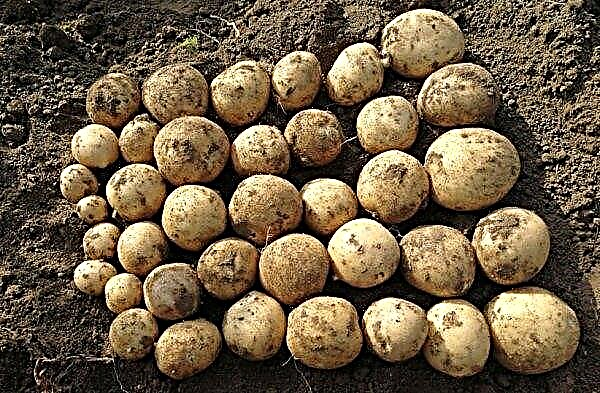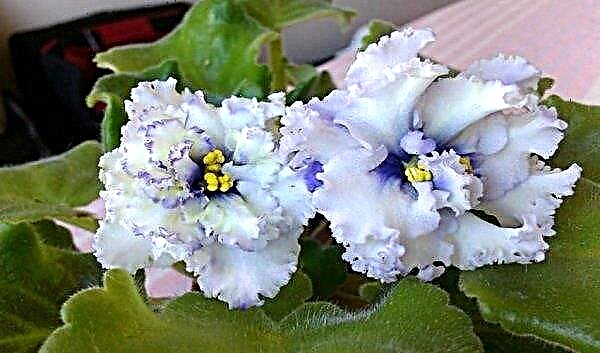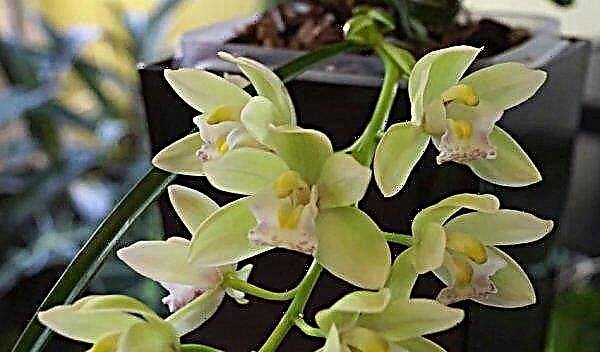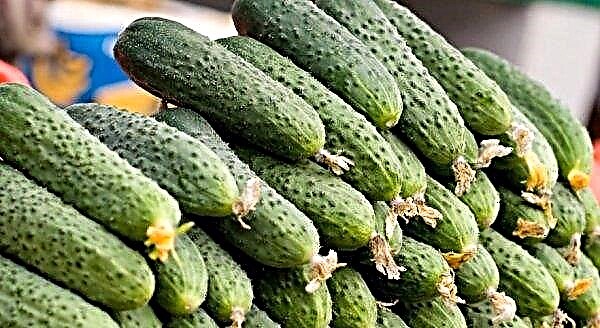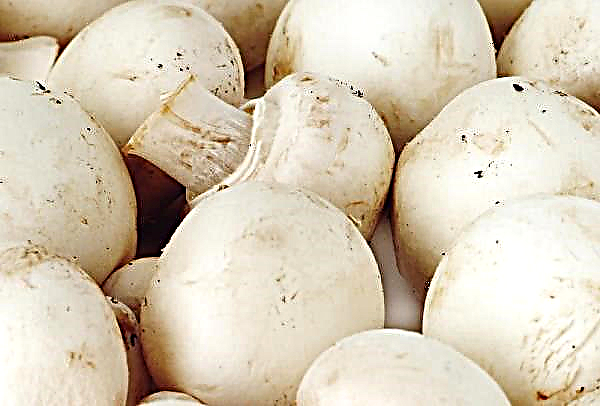Proper and timely care is of great importance for the cultivation of tomato crops. However, a good choice of a variety suitable for specific climatic conditions is no less important. The article will focus on one of the most unpretentious varieties that can be easily cultivated even by a beginner in agriculture - the Miracle of the lazy person.
History of Variety Breeding
Tomato Miracle Lazybone was bred at the seed producer Uralskiy summer resident in collaboration with the Siberian Research Institute of Plant Growing and Breeding. It belongs to the tomatoes of the so-called "Siberian series" and is intended for cultivation in the risky farming zone (in cold regions with a shortage of sunlight).
Did you know? For Siberia, tomatoes continued to be a “strange fruit” until the 50s of the 20th century, when the first cold-resistant varieties with a low flower brush were created.
Characterization and description of the variety
The miracle of lazybones is a determinant variety. The plant is very compact and reaches a height of no more than 45-50 cm. The bushiness of the bush is medium, the leaves are small. At the same time, he has strong stems that can withstand the weight of a plentiful harvest.
Productivity
Fruits together ripen on the 85–95 day since the emergence of seedlings. Even with minimal time and effort spent on caring for the crop, about 8 kg of fruit is usually harvested from 1 m². If you make a little more effort, then the yield can be increased to 9 kg.
Description of the fetus
The following appearance and taste are characteristic of fruits:
- elongated oval shape ("cream") with a spout at the end;
- smooth, dense peel of bright red color;
- weight 60–65 g;
- fleshy flesh with a small amount of small seeds;
- piquant sweet taste with a slight sourness and sharp notes;
- pronounced tomato flavor.
Pros and Cons of Tomato Miracle Lazybone
- The variety is very popular due to its advantages:
- precocity
- high productivity;
- good germination of seeds;
- unpretentiousness in leaving;
- resistance to adverse weather conditions;
- disease resistance;
- good keeping quality;
- ability to easily transport;
- universality (suitable for salads, soups, sauces, preservation, including whole fruit).
When growing the variety in question, you need to consider the following nuances:
- The conditions of the hot southern summer are not suitable for the tomato. At a temperature exceeding + 33 ° C, the ovaries cease to form. That is why it is recommended to cultivate it only in the northern regions and the middle lane.
- Juices can be made from these tomatoes, but due to the dense peel and not juicy pulp, the variety is not an ideal raw material for this type of cooking.
- Growing in greenhouses will be an irrational decision due to the determinism of the variety, which does not allow the maximum use of the greenhouse area.
Did you know? In coastal regions, small fish (capelin, sprat) are added to the soil as top dressing. Phosphorus in its composition contributes to the development of the root system and the setting of inflorescences.
Optimal timing for growing
Seeds for seedlings are sown in late March - early April. In late April - early May, seedlings are planted under the film, and in June - in open ground.
Features of the cultivation of the miracle Lazybones
This tomato is grown mainly through seedlings, although in the middle zone it can be sown with seeds in open ground. Consider seedling technology as the most commonly used.
Growing seedlings
The procedure for growing tomato seedlings Miracle idler does not differ from other varieties and includes the following steps:
- Seed disinfection with a weak potassium permanganate solution for several hours. Then they are washed and covered with a damp cloth, leaving for several days to swell.
- Soil preparation. Turf, rotted humus and river sand are mixed in equal proportions, sieved through a large (5-6 mm) sieve and disinfected in a water bath, in the oven or freezer. Ready-made mineral fertilizers (for example, nitrophosphate) can be added to the soil or feed the soil with an infusion of ash (100 g of wood ash is poured into 10 liters of water and insisted for 2 days).
- The soil is laid out in pots or containers. Seeds are immersed to a depth of 1 cm and sprinkled with earth.
- The future seedlings are sprayed with warm water from the spray gun and covered with a film, placed in a warm (+20 ... + 26 ° C) and sunny place (for example, on the windowsill of the south window).
- Seedlings are regularly watered, preventing the drying of the soil.
- After the appearance of several leaves in the seedlings, seedlings are dived (transplanted into individual containers).
- 2 weeks before planting in open ground, the seedlings begin to temper, placing them in the open air and gradually increasing the residence time from half an hour to a full day. With all the resistance of the variety to weather, the young seedlings should not be exposed to strong winds and too low temperatures (below + 8 ° C).
Preparation of a plot for planting seedlings
The preparation of the garden for planting tomatoes takes place according to the following rules:
- Ideal precursors on the ground will be carrots, pumpkins, cucumbers, onions, cabbage, peas. In turn, potatoes and peppers will not leave useful substances for the tomato, in addition, it is possible to become infected with diseases and pests of Solanaceae.
- The soil should be light and loose, with an acidity index of 6–7. Sandy soils need to be enriched with compost and chernozem.
- In the autumn, they dig the soil, fertilizing humus and prepared top dressing of superphosphate and potassium sulfate (20 g of each drug per 1 m²).
- 10 days before planting, the ground is disinfected by treating with hot water or a weak solution of potassium permanganate.
- Before planting, prepared nitrogen top dressings (10–20 g per 1 m²) are introduced into the wells for seedlings.

Seedling Planting Technology
Having at the disposal of seedlings 60–65 days old and having prepared the soil properly, you can start planting seedlings.
The landing algorithm is as follows:
- Wells 20–25 cm deep are formed.
- The distance between the holes should be 30 cm, and the pitch between the rows should be 50 cm.
- Seedlings are removed from the containers together with a lump of seedlings and dipped one plant per hole.
- The leaves of the seedlings should be above the ground. The roots of the seedlings are placed in a hole at an angle to form additional roots and increase productivity.
- Wells are covered with soil, slightly tamped and watered with warm water.
- In the next 10 days, they do not perform any manipulations with the seedlings (including watering), allowing the roots to take root.
- In cold climates, the first 7-10 days, it is necessary to cover the seedlings with a film that is removed after the seedlings are strengthened.
Video: planting tomato seedlings in open ground
Culture Care Features
The miracle of the idler justifies its name, requiring minimal care. Consider the few agricultural methods that a tomato needs.
Watering
The variety is resistant to both drought and heavy rainfall. However, to get the maximum yield, it is recommended to regularly water the bushes under the root, based on the condition of the soil. Make it warm, warmed up in the sun and protected water. Watering is done after sunset.
Top dressing
Top dressing is optional but desirable.
Tomatoes are fed with fertilizers twice a season:
- 15–20 days after planting in open ground;
- before fruiting.
For top dressing, ready-made complexes containing nitrogen, phosphorus and potassium are used, introducing them along with watering. With the second feeding, 2 times more fertilizer is required than with the first.
Pasynkovka and formation of a bush
Due to the undersized shrubs and medium leafyness, the Lazy Miracle does not require pinching of shoots and pruning of leaves. Tying to a support is also not necessary. The bushes are tied up only if there are too many fruits that threaten to break off the stems.
Soil weeding
It is necessary to timely remove weeds with the root, using a special device - the Fokin plane cutter, while simultaneously loosening the soil with a depth of 3-4 cm.
Important! Mulching (covering the beds with straw or sawdust) will help to avoid the procedure of weeding and loosening, reducing the care of the tomato only to watering and rare top dressing.
Grade Diseases and Pests
The variety is disease resistant, including late blight and viral mosaic. There is no need to treat the bushes with special compounds for prevention.
The only threat is the Colorado beetles, which can be combated with such methods:
- Collect pests manually.
- To process with insecticides ("Antizhuk", "Colorado Forte", "Ratibor").
- Apply folk remedies, for example, ash and wormwood extract. To prepare it, add hot water to a glass of wood ash with 250 g of chopped leaves of fresh wormwood and insist for several hours. After filtering and spraying the bushes.
- Hang birdhouses on the site and raise chickens that feed on bugs.
- Autumn preventive treatment of the plot with a 5% solution of chicken droppings.

Rules for the collection and storage of tomatoes
Tomatoes must be picked on time from the bushes in order to avoid cracking and decay. Each brush forms 12-15 fruits, ripening almost simultaneously. They do not require ripening after collection.
Thanks to the dense peel, tomatoes are well stored under the following conditions:
- at air temperature +5 ... + 12 ° С;
- with an air humidity of about 80%;
- in a dark room;
- being stapled up in wooden or plastic boxes.
Tomatoes are also transported without problems over long distances without losing their presentation.
Important! If the harvest is carried out in cold weather, the tomatoes are kept in hot (60 ° C) water for several minutes to prevent blackening of the fruits before laying them for storage.
Choosing a variety of Miracle Lazybones for your garden, you can be sure of getting high yields as soon as possible with a minimum of effort and not worry about the vagaries of the weather. The variety is suitable for regions with a harsh climate, as well as for gardeners and summer residents of the middle lane who are not able to devote too much time to caring for tomatoes.


